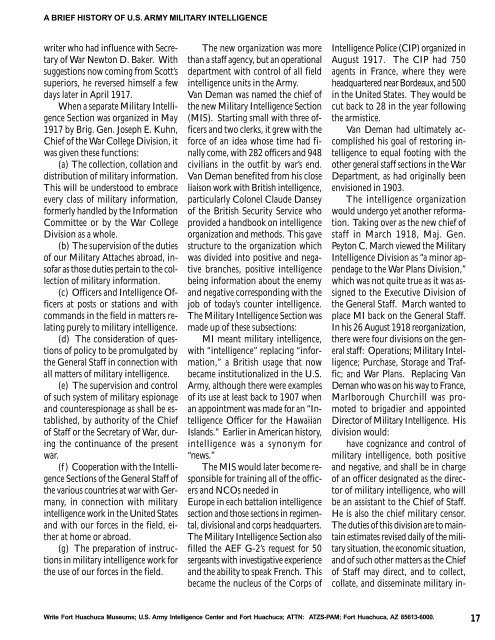Brief History of Army MI - Fort Huachuca - U.S. Army
Brief History of Army MI - Fort Huachuca - U.S. Army
Brief History of Army MI - Fort Huachuca - U.S. Army
You also want an ePaper? Increase the reach of your titles
YUMPU automatically turns print PDFs into web optimized ePapers that Google loves.
A BRIEF HISTORY OF U.S. ARMY <strong>MI</strong>LITARY INTELLIGENCEwriter who had influence with Secretary<strong>of</strong> War Newton D. Baker. Withsuggestions now coming from Scott’ssuperiors, he reversed himself a fewdays later in April 1917.When a separate Military IntelligenceSection was organized in May1917 by Brig. Gen. Joseph E. Kuhn,Chief <strong>of</strong> the War College Division, itwas given these functions:(a) The collection, collation anddistribution <strong>of</strong> military information.This will be understood to embraceevery class <strong>of</strong> military information,formerly handled by the InformationCommittee or by the War CollegeDivision as a whole.(b) The supervision <strong>of</strong> the duties<strong>of</strong> our Military Attaches abroad, ins<strong>of</strong>aras those duties pertain to the collection<strong>of</strong> military information.(c) Officers and Intelligence Officersat posts or stations and withcommands in the field in matters relatingpurely to military intelligence.(d) The consideration <strong>of</strong> questions<strong>of</strong> policy to be promulgated bythe General Staff in connection withall matters <strong>of</strong> military intelligence.(e) The supervision and control<strong>of</strong> such system <strong>of</strong> military espionageand counterespionage as shall be established,by authority <strong>of</strong> the Chief<strong>of</strong> Staff or the Secretary <strong>of</strong> War, duringthe continuance <strong>of</strong> the presentwar.(f) Cooperation with the IntelligenceSections <strong>of</strong> the General Staff <strong>of</strong>the various countries at war with Germany,in connection with militaryintelligence work in the United Statesand with our forces in the field, eitherat home or abroad.(g) The preparation <strong>of</strong> instructionsin military intelligence work forthe use <strong>of</strong> our forces in the field.The new organization was morethan a staff agency, but an operationaldepartment with control <strong>of</strong> all fieldintelligence units in the <strong>Army</strong>.Van Deman was named the chief <strong>of</strong>the new Military Intelligence Section(<strong>MI</strong>S). Starting small with three <strong>of</strong>ficersand two clerks, it grew with theforce <strong>of</strong> an idea whose time had finallycome, with 282 <strong>of</strong>ficers and 948civilians in the outfit by war’s end.Van Deman benefited from his closeliaison work with British intelligence,particularly Colonel Claude Dansey<strong>of</strong> the British Security Service whoprovided a handbook on intelligenceorganization and methods. This gavestructure to the organization whichwas divided into positive and negativebranches, positive intelligencebeing information about the enemyand negative corresponding with thejob <strong>of</strong> today’s counter intelligence.The Military Intelligence Section wasmade up <strong>of</strong> these subsections:<strong>MI</strong> meant military intelligence,with “intelligence” replacing “information,”a British usage that nowbecame institutionalized in the U.S.<strong>Army</strong>, although there were examples<strong>of</strong> its use at least back to 1907 whenan appointment was made for an “IntelligenceOfficer for the HawaiianIslands.” Earlier in American history,intelligence was a synonym for“news.”The <strong>MI</strong>S would later become responsiblefor training all <strong>of</strong> the <strong>of</strong>ficersand NCOs needed inEurope in each battalion intelligencesection and those sections in regimental,divisional and corps headquarters.The Military Intelligence Section als<strong>of</strong>illed the AEF G-2’s request for 50sergeants with investigative experienceand the ability to speak French. Thisbecame the nucleus <strong>of</strong> the Corps <strong>of</strong>Intelligence Police (CIP) organized inAugust 1917. The CIP had 750agents in France, where they wereheadquartered near Bordeaux, and 500in the United States. They would becut back to 28 in the year followingthe armistice.Van Deman had ultimately accomplishedhis goal <strong>of</strong> restoring intelligenceto equal footing with theother general staff sections in the WarDepartment, as had originally beenenvisioned in 1903.The intelligence organizationwould undergo yet another reformation.Taking over as the new chief <strong>of</strong>staff in March 1918, Maj. Gen.Peyton C. March viewed the MilitaryIntelligence Division as “a minor appendageto the War Plans Division,”which was not quite true as it was assignedto the Executive Division <strong>of</strong>the General Staff. March wanted toplace <strong>MI</strong> back on the General Staff.In his 26 August 1918 reorganization,there were four divisions on the generalstaff: Operations; Military Intelligence;Purchase, Storage and Traffic;and War Plans. Replacing VanDeman who was on his way to France,Marlborough Churchill was promotedto brigadier and appointedDirector <strong>of</strong> Military Intelligence. Hisdivision would:have cognizance and control <strong>of</strong>military intelligence, both positiveand negative, and shall be in charge<strong>of</strong> an <strong>of</strong>ficer designated as the director<strong>of</strong> military intelligence, who willbe an assistant to the Chief <strong>of</strong> Staff.He is also the chief military censor.The duties <strong>of</strong> this division are to maintainestimates revised daily <strong>of</strong> the militarysituation, the economic situation,and <strong>of</strong> such other matters as the Chief<strong>of</strong> Staff may direct, and to collect,collate, and disseminate military in-Write <strong>Fort</strong> <strong>Huachuca</strong> Museums; U.S. <strong>Army</strong> Intelligence Center and <strong>Fort</strong> <strong>Huachuca</strong>; ATTN: ATZS-PAM; <strong>Fort</strong> <strong>Huachuca</strong>, AZ 85613-6000.17
















